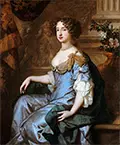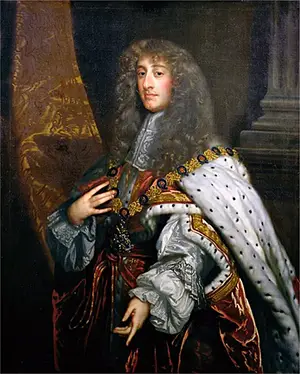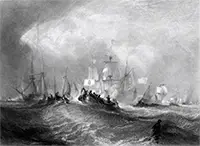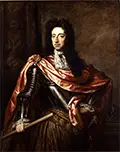William and Mary: Joint Monarchs of England
Part 1: The Background
William was born on Nov. 14, 1650, in The Hague. His father, also named William, died before the boy was born. His mother, Mary, was the oldest daughter of England's King Charles I; she died when her sone was 10. Young William learned from a succession of instructors and grew up looked after by a succession of governesses. He studied under the great Dutch statesman Johan de Witt and then attended the University of Leiden for a time. England and the Netherlands had fought a series of wars in the 1650s, 1660s, and 1670s; in the Third Anglo-Dutch War, England benefited from an alliance with France. It was during that war that William played a major part in bringing the war to an end. He was made captain-general of the Dutch military and stadtholder, the effective head of the Dutch state. 
Mary was the daughter of England's King James II and his first wife, Anne Hyde. Mary was born on April 30, 1662, at St. James' Palace. When she was born, her father was the heir apparent to the king at the time, Charles II. Mary and her sister, Anne, were brought up in the Anglican faith, by royal command of Charles II. The girls lived at Richmond Palace and were effectively rearer by the governess the Lady Frances Villiers. They studied under private tutors and learned dance, drawing, music, and French. With the Third Anglo-Dutch War ended and the two countries no longer at war, the heads of state turned toward making better relations. The marrying of children to make a political alliance was a favorite strategy, and this is what England and the Netherlands did in this case as well. Mary was just 15 on Nov. 4, 1677, when she and the 27-year-old William III of Orange were married in London. They were accepted in great fanfare in London and elsewhere in England. Later that year, they made a grand entry into The Hague, the Dutch capital, having to walk through the countryside at one point because of bad weather. 
One of the things that Charles II (left) did during the Third Anglo-Dutch War was to sign a secret treaty with France's King Louis XIV that brought in aid for the war against the Dutch; as part of this treaty, Charles agreed to convert to Catholicism. Charles secretly believed in the teachings of Catholicism and, in fact, converted to the faith on his death bed. He died on Feb. 6, 1685, and his brother became king. 
James had embraced the Catholic faith in 1669 and was very open about this as he ascended the throne. Tensions over religious beliefs had been high in England for nearly 200 years, after King Henry VIII broke with the Catholic Church and declared himself head of the Church of England. James was not at all willing to declare the Church of England the effective sole faith of the realm. He wanted Catholics to have more rights and more of a public ability to worship the way that they wanted to. Parliament did not agree with such measures, and James dissolved Parliament. He then appointed known Catholics to high-ranking posts within the government and the military. He went a step further in 1687 by issuing a Declaration of Indulgence, which granted complete religious toleration. James's first wife, Anne, who was Mary's mother, died in 1671. James married Mary of Modena, an Italian teenage princess. In June 1688, he and Mary had a son, named James. A group of Protestant nobles had had enough of James and his favoritism toward Catholics, and they saw in the king's son a succession of Catholic monarchs. The solution, as these nobles saw it, was to find another monarch, one who wasn't Catholic. The solution that these monarchs arrived at was to embrace James's daughter Mary (an Anglican from birth) and, more importantly, her husband, the Protestant William of Orange, as the new monarchs. 
William accepted the invitation, gathered a large force of soldiers, and landed in Torbay, in Devon, England, on Nov. 5, 1688. The Dutch force was rather large: More than 400 ships brought more than 15,000 soldiers. Technically, James was able to lay claim to a force of about 25,000 soldiers. However, he had so alienated the English army by this point that most of those soldiers pledged their allegiance to the "invader," William and effectively refused to defend their king and country. James, at this point, fell ill himself and was in no position to fight. He also discovered that his other daughter, Princess Anne, had throw in her lot with her sister and so had her husband, the Prince of Denmark. On December 11, James fled the realm. In February 1689, Parliament decreed that James had abdicated the throne and declared that Mary and her husband, William, were joint monarchs. This set of events was known as the Glorious Revolution.  Next page > Ruling Together > Page 1 2 |
|
Social Studies for Kids
copyright 2002–2024
David White



 William and Mary were the only joint monarchs in the long history of the English monarchy. They ruled in the late 17th Century and early 18th Century and presided over a time of great change called the Glorious Revolution.
William and Mary were the only joint monarchs in the long history of the English monarchy. They ruled in the late 17th Century and early 18th Century and presided over a time of great change called the Glorious Revolution.
